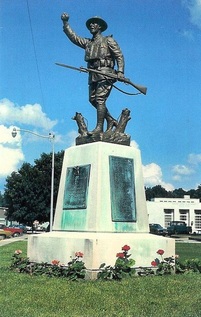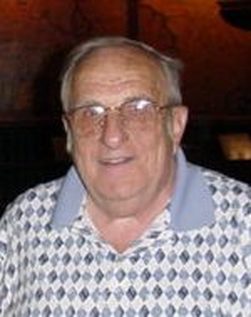INTRODUCTION
Earl D. Goldsmith, The Woodlands, Texas
[Editor's note: Earl passed away March 6, 2018.]

Viquesney's Doughboy
at Spencer, Indiana.
Click photo to enlarge.
at Spencer, Indiana.
Click photo to enlarge.
One of the most reproduced life-size sculptures in the United States is a memorial statue of a World War I American soldier. Our soldiers in that war were popularly called “Doughboys,” and the statue’s proper name is “Spirit of The American Doughboy.” Its sculptor was Ernest Moore “Dick” Viquesney, a son and grandson of French immigrant sculptors. In total, including originals made in Viquesney’s lifetime, replacements of originals, copies, those in storage, etc., about 140 are known to be standing in courthouse lawns, town squares, parks, cemeteries, and other locations, and in storage, all across America. Two that no longer exist are known to have once stood in other locations. Very few local residents in most of its locations have ever known its full proper name or the name of its sculptor. In most locations, it’s merely called “The Doughboy” or “Our Doughboy.” Still, it’s the focal point of over ten- percent of the World War I memorials in the U. S., exclusive of memorials that are limited to merely being plaques. Some people even believe that, except for the Statue of Liberty, its publicly displayed replications are collectively the “most seen” sculpture in the country.
The process of learning the locations of the “Spirit of The American Doughboy” and information about its sculptor, E. M. Viquesney, has required several thousand hours, primarily concentrated in years since 1997. The details of that process are of little general interest, but two warrant mention. Early on, I encountered and got to know T. Perry Wesley of Spencer, Indiana. Things he told me and sent me made my entire quest much simpler than it would otherwise have been. Mr. Wesley is discussed further in this site.
The second is that in 2002, Les Kopel of Oxnard, California contacted me seeking information regarding his search for information about a miniature “Spirit of The American Doughboy” made as a lamp. We have been in nearly constant contact since then. While I’ve been able to help him in some aspects of his project, he has been a tremendous help to me in identifying more Doughboy locations and in adding information about sculptor E. M. Viquesney and many Doughboys to my files. His willingness to have this information on his webite is an even greater help in getting the results of my search publicized. During my search, I’ve talked or corresponded with many, many people such as local librarians, historians, civic, social, fraternal or veteran organizations, museum employees, county veteran service officers, newspaper employees, and local or county officials or employees. I am emotionally indebted to all of them.
The process of learning the locations of the “Spirit of The American Doughboy” and information about its sculptor, E. M. Viquesney, has required several thousand hours, primarily concentrated in years since 1997. The details of that process are of little general interest, but two warrant mention. Early on, I encountered and got to know T. Perry Wesley of Spencer, Indiana. Things he told me and sent me made my entire quest much simpler than it would otherwise have been. Mr. Wesley is discussed further in this site.
The second is that in 2002, Les Kopel of Oxnard, California contacted me seeking information regarding his search for information about a miniature “Spirit of The American Doughboy” made as a lamp. We have been in nearly constant contact since then. While I’ve been able to help him in some aspects of his project, he has been a tremendous help to me in identifying more Doughboy locations and in adding information about sculptor E. M. Viquesney and many Doughboys to my files. His willingness to have this information on his webite is an even greater help in getting the results of my search publicized. During my search, I’ve talked or corresponded with many, many people such as local librarians, historians, civic, social, fraternal or veteran organizations, museum employees, county veteran service officers, newspaper employees, and local or county officials or employees. I am emotionally indebted to all of them.

